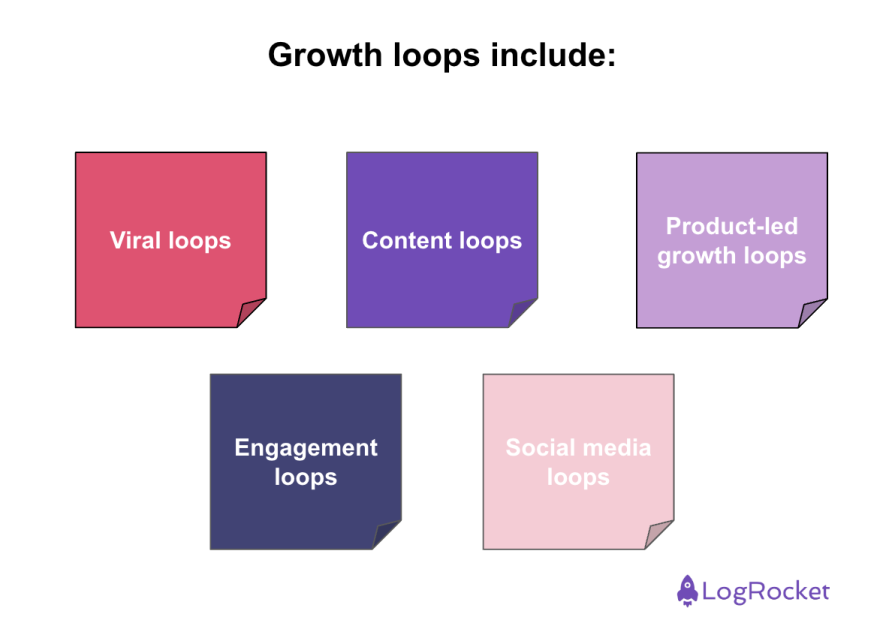The world is changing and it’s getting harder and harder to simply have a good product that drives success. Traditional methods like one-off marketing campaigns or linear sales funnels are becoming more expensive and less effective. Because of this, more and more creative ways are needed to reach customers.

So what if you could build your product in a way that makes your users ambassadors of your product? This way you could seed exponential growth directly into your product’s DNA.
How exactly can you do this? Today’s piece dives into the concept of growth loops, to explore their various types, and discuss how to design and implement them effectively.
Growth loops are a self-sustaining mechanism where certain actions users take lead to the acquisition of more users, creating a compounding effect on growth. Unlike traditional funnels, which are linear and often end after a conversion, growth loops are cyclical processes that continuously feed back into themselves. This means the output from one cycle becomes the input for the next, creating a loop that can drive exponential growth.
In other words, every user acquired to the product with a growth loop should generate additional leads and users, those will then introduce the product to even more people, and so on.
Understanding the different types of growth loops is essential for identifying the ones that’ll fit best with your product and company culture. The most common include:

Viral loops occur when existing users bring in new users through sharing or referrals. The classic example is when a user invites friends to join a platform, often incentivized by rewards or exclusive features. Usually, this takes the form of discounts, extending subscriptions, unlocking unique perks (e.g., character skins in video games), or progressing the product’s gamification system
A great example of that was the initial Dropbox referral program, where users received extra storage space for inviting friends. Any new user would start with 100 MB of free cloud drive, which could be grown to 1GB with referrals and social media posts.
Content loops involve users creating content that attracts more users, who in turn create more content. This loop is common in user-generated content platforms. The goal of this loop is to make it attractive for the viewer to convert to a creator, thus, in theory, bringing more viewers and potential future creators onto the platform.
This is basically the story of the currently most successful YouTuber on the planet: Jimmy Donaldson (MrBeast), who started his creator career as a young teenager due to his love of the platform.
In product-led growth loops, the product itself drives user acquisition and retention. Features are designed to encourage usage that naturally attracts more users. However this is a double-sided sword — if the product loop doesn’t kick off, the product can’t really function.
Examples of these loops include social networks and communicators. Frankly, as an ex-Skype PM, I can share that one of the issues we faced back when I was on the team was that new Skype users were not attracting their social circles to also use the product. This really hindered growth and was one of the key challenges to overcome.
This type of loop focuses on increasing user engagement to the point where users become advocates for the product, indirectly attracting new users. For example, Strava, a fitness app, encourages users to share their workout achievements on social media, promoting the app to their network. Other examples include challenges or game modes in video games that require more than one player to complete.
With this loop, it’s more about being visible on sites like Instagram, LinkedIn or Facebook. It’s a tad roundabout way of achieving success and unpredictable at best. It all relies on achieving the post’s virality in order to bring attention to the brand.
As more and more people share and engage with the content, the more potential clients learn about the brand and the product, which can end up with a sale. At the same time creating consistent viral content is really challenging and should not be considered a main, reliable growth loop for most of the products.
It probably goes without saying that no growth can be called such without having data to back it up. To ensure your growth loop is effective, you need to track the right metrics. Typical metrics to consider include:
Creating a successful growth loop isn’t about copying what others have done. It’s about designing a loop that fits your product, matches users’ expectations, and aligns with your business goals. Here are the key steps you should take:
Your growth loop should reinforce the core value your product offers. In other words, it needs to be seamless and organic. If the loop feels forced or doesn’t add value to the user, it’s unlikely to be effective.
For example, while gamification is at the core of how Duolingo became so successful and effective, a similar mechanism didn’t really work when I implemented it in a job board mobile app. While it did bring a boost in core metrics, it always felt tacked on and trivialized the often long and stressful process of job search. There also weren’t any rewards for reaching the gamification goals other than animations and cheering messages.
Following the conclusions from the previous step, you need to determine which type of growth loop aligns with your product and audience. Remember, the growth loop won’t fit every product equally and in the end, it’ll come to crafting an experiment to determine whether the choice made in the step works or not.
Now, it’s time to visualize each step in the loop, identifying inputs, outputs, and potential friction points. The actions required to complete the loop should be as effortless as possible. Any friction can hinder the loop’s ability to sustain itself.
Look where in your product you can introduce the loop mechanism so that it requires as few screens and steps as possible. Perhaps it’s a good idea to consider several small loop entry points in your product. Maybe even go back a step and consider more than one loop? This design phase also incorporates choosing product features that’ll facilitate the loop.
Like with any other new development, you’ll need to test your loop in action. This is a case where you may consider dropping the A/B test and simply monitor how the growth loop does with your chosen success metrics. Of course, when determining the result, be data-driven. See what worked and double down on it, and fix whichever part of the loop underperforms.
When preparing for this article, I was looking for a good, and not well-known, example to present as a case study. Then it hit me. I executed my own successful growth loop four years ago.
It all started when I launched my online product management course. Back then I had no audience, no popularity, and no marketing budget. All I could do was leverage my skills and free tools at my disposal.
While the initial goal was to gather an audience, it quickly evolved into building a personal brand while doing so. The solution that emerged (I can’t say it was a strategic plan) was a loop consisting of four entry points to learn about me and what I do: A course, a YouTube channel, social media, and a blog. Every element of this loop connected a potential follower/student to the other three, providing value every step of the way.
This worked much better than expected and today I am happy to show over 117,000 followers on LinkedIn. As time went by, I semi-abandoned the YouTube channel and blog, as the other two elements of this loop performed way better:

Growth loops offer a powerful way to achieve sustainable, exponential growth by turning your users into active participants in your growth strategy. By understanding the different types of growth loops and how to design them effectively, you can transform the way your product acquires and retains users. Remember to align your growth loop with your core value proposition, remove friction to make participation effortless, and continuously measure and optimize using data.
Implementing these principles allows you to create self-sustaining growth engines that drive your product forward. Thank you for reading this blog post and hopefully, see you in the next piece! In the meantime, good luck growing your product.
Featured image source: IconScout

LogRocket identifies friction points in the user experience so you can make informed decisions about product and design changes that must happen to hit your goals.
With LogRocket, you can understand the scope of the issues affecting your product and prioritize the changes that need to be made. LogRocket simplifies workflows by allowing Engineering, Product, UX, and Design teams to work from the same data as you, eliminating any confusion about what needs to be done.
Get your teams on the same page — try LogRocket today.

Most teams fail at autonomy. Learn how clear rules help product teams move faster without micromanagement.

A practical framework for PMs to use AI in ideation without sacrificing judgment, strategy, or decision quality.

A practical five minute revenue estimation method to help product managers compare ideas, drop low impact features, and prioritize smarter.

A practical guide for PMs who want to stop being bottlenecks, delegate smarter, and lead teams effectively with a clear ownership framework.